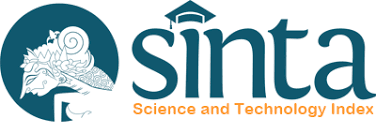Development of tempe products high in iron and protein with substitution of chicken liver flour to improve iron deficiency anemia
DOI:
https://doi.org/10.22236/argipa.v9i1.13319Keywords:
Chicken liver flour, Iron, Protein, Soybean tempehAbstract
Iron deficiency can interfere with the formation of hemoglobin, causing iron deficiency anemia. If iron deficiency anemia continues during pregnancy, it can increase the risk of giving birth to a baby with stunting and anemia. This study aimed to develop a food product high in iron and protein by substituting chicken liver flour with soybean tempeh to produce a tempeh product that can be used as an alternative food to improve iron deficiency anemia. This study used a completely randomized design. The treatment in this study consisted of four levels of chicken liver flour substitution (F1=5%, F2=10%, F3=15%, and F4=20%) in making tempeh. Hedonic quality test data were statistically analyzed using the Mann–Whitney test. The data on iron level using the Atomic Absorption Spectrophotometry (AAS) method and protein level using the Kjeldahl method were statistically analyzed using the one-way ANOVA test and continued with the Tamhanes test. The results of this research show that the substitution of chicken liver flour produces products with iron and protein levels at the level of 10% (1.330 mg/100 g; 18.76 g/100 g), 15% (5.355 mg/100 g; 21.36 g/100 g) and 20% (3.089 mg/100 g; 25.31 g/100 g) respectively which were higher than the control group (p<0.05). The highest iron levels were obtained in group F3 with an iron level of 5.355 mg/100, and the highest protein levels were obtained in group F4 with a protein level of 21.36 g/100 g. Based on the hedonic quality test, the substitution of chicken liver flour reduced the quality of tempeh in several parameters, namely non-white color, pungent aroma, and tasteless taste typical of tempeh, compared to the control group (p<0.05). The substitution of chicken liver flour with concentrations of 10%, 15%, and 20% can increase iron and protein levels in tempe products.
Downloads
References
Abdullah, A. (2015). The Double Burden of Undernutrition and Overnutrition in Developing Countries: an Update. Curr Obes Rep, 4(3), 337–349.
Alfiah, E., Briawan, D., Khomsan, A., Dewi, M., Ekayanti, I., Mardewi, Raut, MK., Zakaria, A., & Roche, ML. (2020). Coverage and Adherence of Weekly Iron Folic Acid Supplementation among School Going Adolescent Girls in Indonesia. J Nutr Sci Vitaminol, 66(Supplement), S118–S121.
Andriastuti, M., Ilmana, G., Nawangwulan, SA., & Kosasih, KA. (2020). Prevalence of anemia and iron profile among children and adolescent with low socio–economic status. Int J Pediatr Adolesc Med, 7(2), 88–92.
Blanco–Rojo, R., Toxqui, L., López–Parra, AM., Baeza–Richer, C., Pérez–Granados, AM., Arroyo–Pardo, E., & Vaquero, MP. (2014). Influence of diet, menstruation and genetic factors on iron status: A cross–sectional study in Spanish women of childbearing age. Int J Mol Sci, 15(3), 4077–87.
BPS. (2023). https://www.bps.go.id/statictable/2014/09/08/950/rata–rata–konsumsi–perkapita–seminggu–beberapa–macam–bahan–makanan–penting–2007–2017.html (Accessed on 07 April 2023).
BSN. (2012). Tempe: Persembahan Indonesia untuk Dunia. Jakarta: Badan Standardisasi Nasional.
Chifman, J., Laubenbacher, R., & Torti, SV. (2014). A systems biology approach to iron metabolism. Adv Exp Med Biol. 844, 201–225.
Falkingham, M., Abdelhamid, A., Curtis, P., Fairweather–Tait, S., Dye, L., & Hooper, L. (2010). The effects of oral iron supplementation on cognition in older children and adults: a systematic review and meta–analysis. Nutr J, 9:4, 1–16.
Han, O. (2011). Molecular mechanism of intestinal iron absorption. Metallomics, 3, 103–109.
Harahap, KS., Sumartini, & Mujiyanti, A. (2020). Pengujian hedonik pada formulasi cookies coklat dari tepung mangrove Avicennia officinalis dengan penambahan tepung kacang merah, wijen, dan hati ayam. Aurelia Journal, 2(1), 19–28.
Hu, PJ., Ley, SH., Bhupathiraju, SN., Li, Y., & Wang, DD. (2017). Associations of dietary, lifestyle, and sociodemographic factors with iron status in Chinese adults: a cross–sectional study in the China Health and Nutrition Survey. Am J Clin Nutr, 105(2), 503–12.
Hurrell, R., & Egli, I. (2010). Iron bioavailability and dietary reference values. Am J Clin Nutr, 91(5), 1461S–1467S.
Kementerian Kesehatan Republik Indonesia. (2013). Riset Kesehatan Dasar (RISKESDAS 2013). Jakarta: Badan Penelitian dan Pengembangan Kesehatan.
Kementerian Kesehatan Republik Indonesia. (2018). Hasil utama Riset Kesehatan Dasar (riskesdas) 2018. Jakarta: Badan Penelitian dan Pengembangan Kesehatan.
Kementerian Kesehatan Republik Indonesia. (2018). Tabel Komposisi Pangan Indonesia. Jakarta: Kementerian Kesehatan RI.
Knutson, MD. (2017). Iron transport proteins: Gateways of cellular and systemic iron homeostasis. J Biol Chem, 292(31), 12735–12743.
Lopez, A., Cacoub, P., Macdougall, IC., & Peyrin–Biroulet, L. (2016). Iron deficiency anaemia. Lancet, 387(10021), 907–16.
Muzayyanah, MAU., & Dewi, NHU. (2019). Determinants of household beef consumption in Indonesia: a binary logistic analysis. IOP Conf. Series: Earth and Environmental Science, 387, 012107.
Niquini, RP., Bittencourt, SD de A., Lacerda, EM de A., Saunders, C., & Leal, M do C. (2016). Factors associated with non–adherence to prescribed Iron supplement use: A study with pregnant woman in the city of Rio de Janeiro. Rev Bras Saude Mater Infant, 16(2), 189–99.
OECD. (2023). Meat consumption (indicator). doi: 10.1787/fa290fd0–en (Accessed on 07 April 2023)
PERMENKES RI. (2019). Angka kecukupan gizi yang dianjurkan untuk masyarakat Indonesia. Peraturan Kementerian Kesehatan Republik Indonesia Nomor 28 Tahun 2019. Kemenkes.
Santosa, H., Handayani, NA., Nuramelia, C., & Sukma, NYT. (2016). Pemanfaatan Hati Ayam sebagai Fortifikan Bubur Bayi Instan Berbahan Dasar Ubi Jalar Ungu (Ipomea Batatas L.). Inovasi Teknik Kimia, 1(1), 27–34.
Seong, PL., Cho, SH., Park, KM., Kang, GH., Park, BY., Moon, SS., & Ba, HV. (2015). Characterization of chicken by–products by mean of proximate and nutritional compositions. Korean J Food Sci Anim Resour, 35(2), 179–188.
Sinha, S., Pereira-Reis, J., Guerra, A., Rivella, S., & Duarte, D. (2021). The role of iron in benign and malignant hematopoiesis. Antioxid Redox Signal. 35(6), 415–432.
Sunuwar, DR., Singh, DR., Chaudhary, NK., Pradhan, PMS., Rai, P., & Tiwari, K. (2020). Prevalence and factors associated with anemia among women of reproductive age in seven South and Southeast Asian countries: Evidence from nationally representative surveys. PLoS One, 15(8), e0236449.
Tampy, ST., Nugroho, HW., & Syuadzah, R. (2020). Association between Maternal Anemia with Stunting Incidence among Newborns in Surakarta, Central Java. The 7th International Conference on Public Health, 191.
Utami, MMH., Kustiyah, L., & Dwiriani, CM. (2023). Risk Factors of Stunting, Iron Deficiency Anemia, and Their Coexistence among Children Aged 6–9 Years in Indonesia: Results from the Indonesian Family Life Survey–5 (IFLS–5) in 2014–2015. Amerta Nutrition, 7(1), 120–30.
Wiafe, MA., Apprey, C., & Annan, RA. (2020). Patterns of dietary iron intake, iron status, and predictors of haemoglobin levels among early adolescents in a rural ghanaian district. J Nutr Metab, 1–10.
World Health Organization. (2011). Haemoglobin concentrations for the diagnosis of anaemia and assessment of severity. World Health Organization. 1–6.
Zhang, A., & Enns, CA. (2022). Grab and go: transferrin uptake in erythropoiesis. Blood, 140(10), 1061–1063.
Downloads
Published
How to Cite
Issue
Section
License
Copyright (c) 2024 ARGIPA (Arsip Gizi dan Pangan)

This work is licensed under a Creative Commons Attribution 4.0 International License.

















